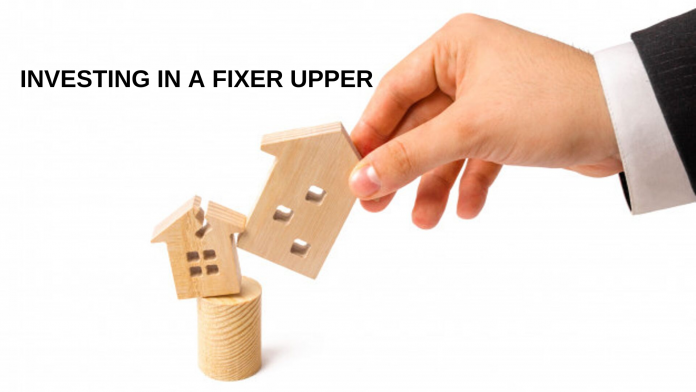Buying real estate is, without a doubt, one of the best ways to make money and build a portfolio of investments. Even though rental properties are the most common types of real estate, not everyone has a lot to spend on the purchase of these investments. If this is the case for you, you might consider investing in a fixer-upper. Fixer-uppers are homes that need either minor or significant renovation before they can be used as residential properties. These types of properties are often purchased by property investors with the intention of “flipping” them.
While investing in a fixer-upper is definitely a common real estate investment strategy, they also carry risks and can turn into a money pit. As a real estate investor, how can you determine if buying a fixer-upper property is worth the investment? Here are some pros and cons of this type of investment to consider:
The Pros of Investing in a Fixer-Upper
Pro #1: Less Competition
In the real estate investing business, finding a good, nice, and essentially “the perfect” investment property can be tough because nearly every other real estate investor is looking for the same qualities.
Most property investors search for a rental property that is ready for the tenant to move into and start making rental income, not a project that they have to work on. This is true for both single-family and multi-family homes.
This is where investing in fixer-uppers becomes a popular path. Fixing up a home is a lot of work, which is why not any real estate investor is willing to invest in a fixer-upper.
However, this is good news for you if house flipping is your investment strategy of choice as you’ll deal with fewer competitors. Instead of competing with hundreds of property investors eyeing the same house, you’d be competing with about 10% of those who are willing to look at fixer-upper properties AND you’re far less likely to end up in a bidding war. This gives you more room for negotiations with the seller, without other real estate buyers getting in the way.
Pro #2: Forced Appreciation
Appreciation refers to the concept that properties gain value over time. Rental properties typically need 10 years in order to naturally appreciate (taking factors like location and property type into account, of course). With a fixer-upper investment property, on the other hand, property investors actually force appreciation as they renovate (or rehabilitate) the house. This is where the investing aspect of fixer-uppers comes into play.
For example, say you buy a fixer-upper investment property for 26,000,000 and spent an additional 4,000,000 on renovating the kitchen, flooring, painting, and others. These renovations have added value to your investment property, which now has 30,000,000 invested in it. When the time comes to sell the fixer-upper, a savvy real estate investor (who analyzed the after repair value before purchasing) will be able to list it at a much higher price than what he/she initially purchased it. So, you can sell the 26,000,000 investment property for 40,000,000 (or more!), and reap a good profit margin. The more you put into your fixer-upper, the more return on investment you’ll potentially get – especially if you purchased it below its market price.
Pro #3: Potential Cash Flow
Buying fixer-uppers allows you to buy for far less than move-in ready rental properties on the real estate market. When buying a property with a mortgage loan, property investors make mortgage payments based on the full price of that property. These payments – along with other rental expenses – can diminish the amount of cash flow you’ll have from a rental property. With a fixer-upper, however, it’s a different story.
Let’s go back to our previous example to further clarify. After fixing it up, this fixer-upper is now worth 40,000,000 but, since mortgage payments are fixed, you’d only be making payments on the 26,000,000 you originally bought. In addition, if you’re planning to rent out the house after renovating it, you can rent it out for what a 40,000,000 property would rent for but, once again, pay the mortgage of a 26,000,000 home. Thus, you’ll reduce a portion of your rental expenses which, in turn, lead to more cash flow from the investment property!
The Cons of Investing in a Fixer-Upper
Con #1: Hidden Expenses
With fixer-upper investment properties, a real estate investor goes in knowing that there’s some maintenance or fixing that needs to be done. Hence, the importance of planning and preparing for the expenses you’ll need to cover.
However, it’s hard to accurately estimate the total rehab costs. In addition, unexpected problems may occur while you’re doing the work, leading to spending more than what you had originally planned for. This is why property investors need to always conduct an extensive home appraisal or inspection before buying a fixer-upper, set a detailed budget, and plan for unexpected expenses to occur.
Con #2: Harder to Finance
If you think financing fixer-uppers is easier because they’re cheaper than move-in ready rental properties, think again. Although a fixer-upper is cheaper in price, finding the funds and financing to buy one can be tough to navigate. First of all, there are less “standard” options available for real estate investors to finance this type of investment property.
Secondly, most lenders don’t offer favourable financing options for investment properties that need a lot of work. You can turn to private money or hard money lenders, but finding a suitable lender with reasonable rates is still a struggle. Unless a home renovation loan is secured, a real estate investor needs to have cash in hand.
Con #3: Uncertain Future
In order to make the most profits from a fixer-upper, property investors need to work on renovations and have a buyer (or tenant) as quickly as possible. Now, a couple of things could go wrong and interfere with this. Unless you’re an expert in flipping houses, it can be difficult to know how much work the investment property really needs. Damage that looks like a cosmetic defect may turn out to actually be a symptom of structural damage, mold, rot, or other costly problems. Thus, the time needed to finish renovation might be longer than expected. Once again, this proves the importance of getting a detailed home inspection before buying a fixer-upper.
Another problem that may occur is not finding an end-buyer or a tenant ready to move into the flipped house once renovations are complete. As a result, a real estate investor might get stuck paying for the mortgage on a fixer-upper that is not making any rental income in return. Moreover, the housing market can be a roller coaster.
You might spend a lot of money on adding value to the investment property only to find out that by the time you’ve put it on the market, houses in the area are selling for less than what you’ve initially thought. In this case, your profits will drop and you’ll be in for a loss. For property investors, this should teach you the importance of knowing the right time to sell a fixer-upper!
The Bottom Line
A lot of people dream of buying a house for cheap and flipping it, but is that a smart investment strategy? That’s up to you to decide! When you know what you’re doing, investing in a fixer-upper property could be a great way to make money in real estate.
However, property investors must always be aware of the risks and challenges that may come up along the way in order to know how to act in case they occur. Will you consider buying a fixer-upper? Let us know why or why not in the comments below!
Kenya Homes gives property investors the necessary tools to help them make the best investment decisions and find the best properties to invest in and make money.














